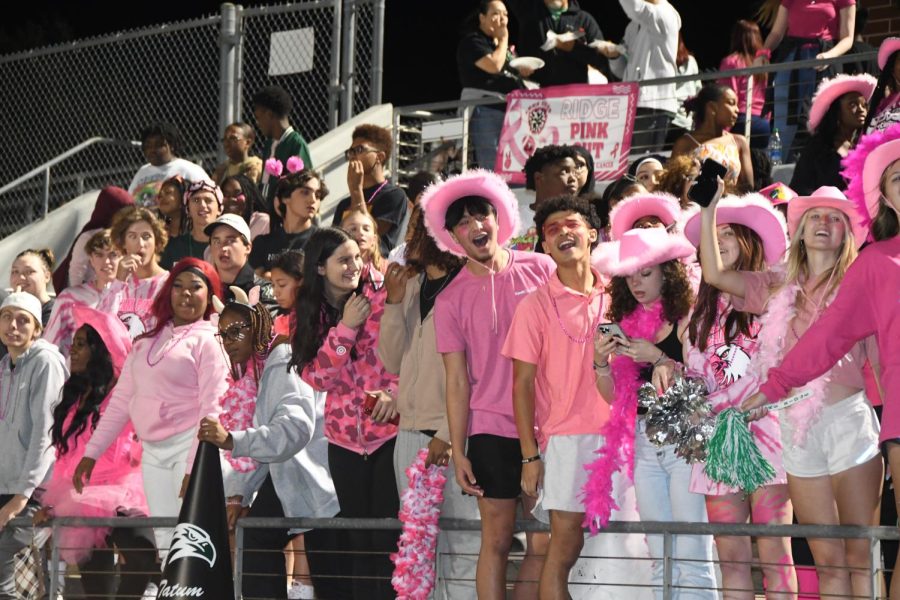What Pink Really Means
Through events like Pink Out students are learning the impact of cancer.
The color pink has been commonly associated with many shows and movies such as Mean girls, Legally blonde and Grease. However, the true meaning of pink runs deeper than its significance within pop culture. Pink has been the color to represent Breast Cancer awareness month since 1991.
The first pink ribbon to represent breast cancer awareness was actually not bright pink, it was a light peach color. In 1991 Charlotte Haley, a breast cancer survivor, was trying to raise awareness about the lack of funding for cancer prevention. She sent out thousands of cards with the peach ribbons attached, and her message ended up striking a cord.
Just months before the end of 1990, the Susan G. Komen Breast Cancer Foundation began incorporating pink into their cause by handing out pink visors to women who participated in Race for the Cure races. Then in the fall of 1991, after ribbons were successfully raising awareness, the foundation began handing out pink ribbons during their New York City race. To this day the color pink, especially a pink ribbon, is the international symbol for breast cancer awareness.
According to ‘Colors explained’ the color pink is commonly thought of as a romantic color or the color of love. Pink is the color of universal love – for oneself and others. It embodies all that is good in the world, showing an unmatched level of sympathy. Taylor Crockett, Sophomore explains what she thinks the color pink means.
“I think pink is a very bold and strong color; it’s now commonly associated with breast cancer. Overall pink is very courageous because it represents breast cancer survivors who are very strong, women who have overcame a challenge in their life,” says Crockett.
Every year, charities, businesses and organizations use pink to associate themselves with the promotion of breast cancer awareness and fund-raising for various charities. Many High schools do ‘Pink out’ in which students dress head to toe in the color pink. Similar to wearing the pink ribbon, participating in ‘Pink out’ helps recognize and support women battling or who have survived breast cancer. Rebekah McKnight, art teacher explains why we wear pink during breast cancer month.
“Wearing pink helps us think about survivors and makes sure we are having discussions about breast cancer. That even means donating either time or money to organizations who help breast cancer survivors,”
With having a pink out pep rally and events any student can wear the color pink during pink out and not know the true meaning behind it. From wearing pink throughout October and attending all-pink events shows that people support the cause but just wearing pink is not enough. With many things, it is the action not the words that count. Crockett explains that people can be more informed on the subject than just wearing pink during pink out.
“I don’t think just wearing pink is enough. I feel like we should talk about it more and not just wear the color because you should forget what pink really means when associated with breast cancer awareness,” says Crockett.
Isabella Cortez, Senior says that just dressing in pink is not as sufficient compared to being proactive.
“I don’t think just wearing pink is enough because the shirt that the school sells, I don’t know where that money goes and I feel like not a lot of people know about being proactive about the subject. I think donating and being more educated on the topic is more helpful,” says Cortez.
Motivation can go a long way when people are dealing with life altering things like cancer. Pink out and Breast Cancer awareness month not only shines a light on something that hundreds of women around the world face, but it also sparks support and motivation to keep going. Cortez’s mom was diagnosed a year ago in May with stage 1 Breast Cancer. She says that the support and motivation from pink out had motivated her mom.
“It does mean a lot to her that people support her and show awareness of her cause. Although it might remind her about her experiences, it also reminds her that she stayed strong and overcame it,” says Cortez

- Grade 12 with 4 years of experience.
Hi! My name is Valeria Ramirez and I'm the Publishing Editor for Newspaper. I was motivated to join to strengthen...

